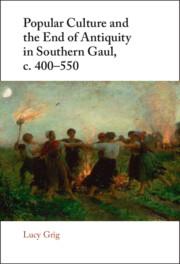Book contents
- Popular Culture and the End of Antiquity in Southern Gaul, c. 400–550
- Popular Culture and the End of Antiquity in Southern Gaul, c. 400–550
- Copyright page
- Contents
- Figures
- Maps
- Acknowledgements
- Abbreviations
- Maps
- Chapter 1 Introduction
- Chapter 2 Urban Contexts for Popular Culture in an Age of Transformation
- Chapter 3 Popular Culture, Society and Economy
- Chapter 4 Christianizing Popular Culture
- Chapter 5 An Alternative View
- Chapter 6 The Kalends of January
- Chapter 7 Conclusions
- References
- Index
Chapter 5 - An Alternative View
Lived Religion As Popular Culture
Published online by Cambridge University Press: 15 March 2024
- Popular Culture and the End of Antiquity in Southern Gaul, c. 400–550
- Popular Culture and the End of Antiquity in Southern Gaul, c. 400–550
- Copyright page
- Contents
- Figures
- Maps
- Acknowledgements
- Abbreviations
- Maps
- Chapter 1 Introduction
- Chapter 2 Urban Contexts for Popular Culture in an Age of Transformation
- Chapter 3 Popular Culture, Society and Economy
- Chapter 4 Christianizing Popular Culture
- Chapter 5 An Alternative View
- Chapter 6 The Kalends of January
- Chapter 7 Conclusions
- References
- Index
Summary
This chapter looks at popular culture through the lens of lived religion, with a particular focus on the late antique countryside. After an initial discussion exploring the dimensions of ‘lived religion’, it is then explored through two extended case studies. The first looks at ritual practices associated with the midsummer feast of John the Baptist, including ritual bathing. The second case study looks at ritual activities aimed at mitigating the effects of hail, a persistent threat to agriculture and viticulture in the region. These rituals, and the responses from church and secular elites and authorities alike, are examined in their social and economic context. A range of different types of evidence is considered, from charms through to imperial legislation, as well as ecclesiastical texts of various kinds.
- Type
- Chapter
- Information
- Publisher: Cambridge University PressPrint publication year: 2024

